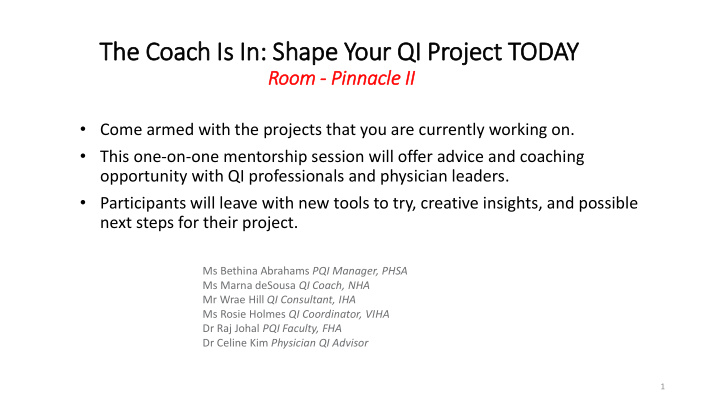



The Coach Is Is In In: Shape Your QI I Project TODAY Room - Pinn innacle le II II • Come armed with the projects that you are currently working on. • This one-on-one mentorship session will offer advice and coaching opportunity with QI professionals and physician leaders. • Participants will leave with new tools to try, creative insights, and possible next steps for their project. Ms Bethina Abrahams PQI Manager, PHSA Ms Marna deSousa QI Coach, NHA Mr Wrae Hill QI Consultant, IHA Ms Rosie Holmes QI Coordinator, VIHA Dr Raj Johal PQI Faculty, FHA Dr Celine Kim Physician QI Advisor 1
Dis isclo losure These presenters do not have anything to disclose 2
Agenda: Shape/ Re-Shape Your PQI I Project 1:20-1:25 (5 min) Review your feedback (slides 3-5) • What are your needs ? makes sense to you ? • Scoping / Measures/ Common problems* • Arrange into 4 groups (perhaps by focus areas ?) 1:25- 1:40 (15 min ) Didactic – Driver Diagram (slides 6-10 incl. 7 min video) Driver Diagrams / a precursor to building your PQI charter https://www.youtube.com/watch?v=ck4kZ_4CVPc 1:40- 2:00 (20 min) Practice - Driver Diagram (slide10) 5-6 people / table + 2 PQI Coaches • Timing is flexible up to 30 min max • Resource : Driver Diagram – fillable .pdf BCPSQC • One-on-one mentorship / Practical advice / Coaching opportunity • Apply new tools to your project / seek creative insights / think about next steps for your project. • Feedback at your tables : Common issues / common solutions ? 2:00- 2:20 ( 20 min) Q & A – Your questions regarding shaping your projects (slides 11-13) • Driver Diagrams as a precursor to building your PQI charter (useful ?) • QI charters / purpose as living documents vs. blue print • What sponsorship really means • Your take home: A completed driver diagram to inform your PQI project / Charter iteration 2:20-2:45 (Time permitting) Sustainability Assessment (slides 14-15) • Do you have the right ingredients for success ? 3
4
5
Feedback “The Coach is In” seminar registrants Brief panel introduction showing / acknowledging these needs & feedback • Like a Physician visit: Listening / Data / Educated guess - What may help you ? • Precursor to QI charters: PQI project shaping in advance of the cohort is KEY.. Having an operational team and a clear outcome (basic AIM) is key. Basic measures , such as those in an updated driver diagram, are central to communication & keeping a PQI project on track … • Having a team is crucial. QI Charters while crucial , may not the best place to start and language (Sponsorship) may be problematic for Physicians (Driver Diagram) • Assess & reassess crucial components of your PQI project (NHS sustainability model ) 6
Driver Diagrams & Activity OUTCOME: Participants start rethinking about who to engage & how. TIME : 15 minutes LEARNING: Driver Diagram (6.5 min) https://www.youtube.com/watch?v=ck4kZ_4CVPc RESOURCES: https://qi.elft.nhs.uk/resource/driver-diagrams/ EXERCISE : 20 minutes Completed a driver diagram w/ a family of practical measures for your project Outcome: Measurable, as a result of your changes Process: Changes themselves (form completed/ time to therapy) Balancing : Unintended consequences TAKE HOME : Have a completed a driver diagram w/ a family of practical measures for your project 7
8
The Model - Example Change Idea Secondary Change Idea Driver Change Idea Increase referrals to Trial the Reduce the Breathe standardized Improve Well program awareness of discharge readmissions community form (which resources includes the for COPD by and services Breathe Well referral) 50% by Sept Secondary 1, 2015 Change Idea Driver Primary Driver Change Idea Secondary BCPSQC Driver Change Idea 9
From Driver Diagram to Improvement Model 10
PRACTICE : Flip the IHI Improvement Model on it’s side = Driver Diagram AIM DATA (Measures) IDEAS AIM DATA IDEAS Outcome: Measurable, as a result of your changes Process: Changes themselves (form completed/ time to therapy) Balancing : Unintended consequences 11
Q & A – Your questions / Shaping your proje jects • Driver Diagrams as a precursor to building your PQI charter (useful ?) • QI charters / purpose as living documents vs. blue print • http://www.ihi.org/education/IHIOpenSchool/resources/Assets/QIProjectCharter_Worksheet.pdf • Outcome: Measurable, as a result of your changes Process: Changes themselves (form completed/ time to therapy) Balancing : Unintended consequences • What sponsorship really means • Completed a driver diagram w/ a family of practical measures for your project • Your take home: • A completed driver diagram to inform your PQI project / Charter iteration 12
13
All PQI teams have some evaluation methodology to determine if the idea & Physician are a fit Common components : • Do you have a team ? • Evidence is strong ? • Clear AIM and deliverables ? • Is this doable ? • Robust data strategy ? • Review by PQI Steering Ctte (or proxy) 14
Sustainability Assessment ( Do you have the necessary ingredients ?) OUTCOME: Objectively look at your project’s likelihood of being successful now and over time. LEARNING: https://improvement.nhs.uk/resources/sustainability-model/ Assess three major domains: • Process/ • Staff onboard/ • Infrastructure RESOURCES: NHS sustainability model ; Questions Pages 3-7 (scoring matrix pg. 8) EXERCISE : Score your pr oject’s likelihood of being successful now and over time 15
Example ; Proactive Blo lood Mana anagement ( IV Iron for Anemia pre-op vs. reliance upon Transfusion) Halfway through a PQI cohort project My score Max score Benefits 8.5 8.5 Sustainability Credibility of evidence 6.3 9.1 Adaptability 3.4 7.0 Monitoring Progress 2.4 6.5 Benefits 16.0 Involvement and training 6.3 11.4 Infrastructure Credibility of evidence Behaviours 5.1 11.0 12.0 Senior leaders 5.7 15.0 8.0 Clinical leaders 6.7 15.0 Fit with goals and culture Adaptability Fit with goals and culture 3.3 7.0 4.0 Infrastructure 3.3 9.5 0.0 Clinical leaders Monitoring Progress Senior leaders Involvement and training Behaviours 16
Recommend
More recommend